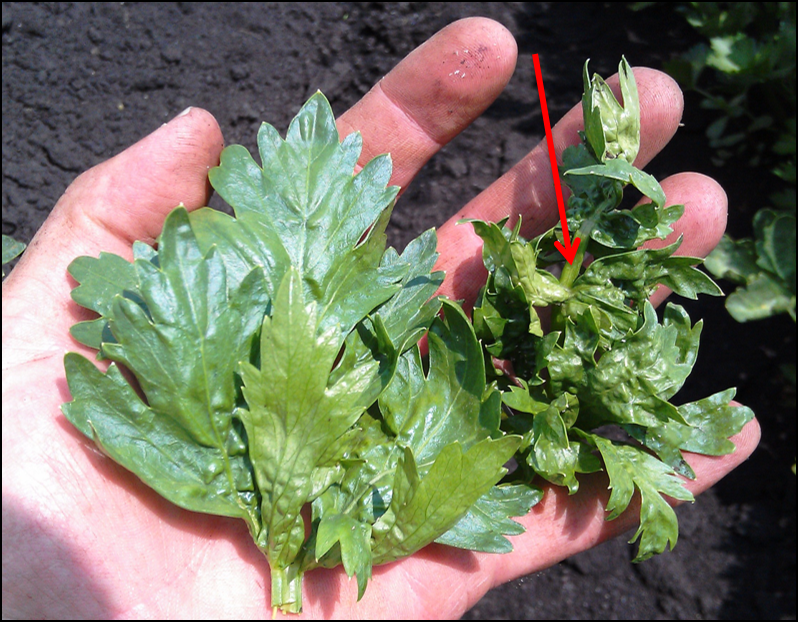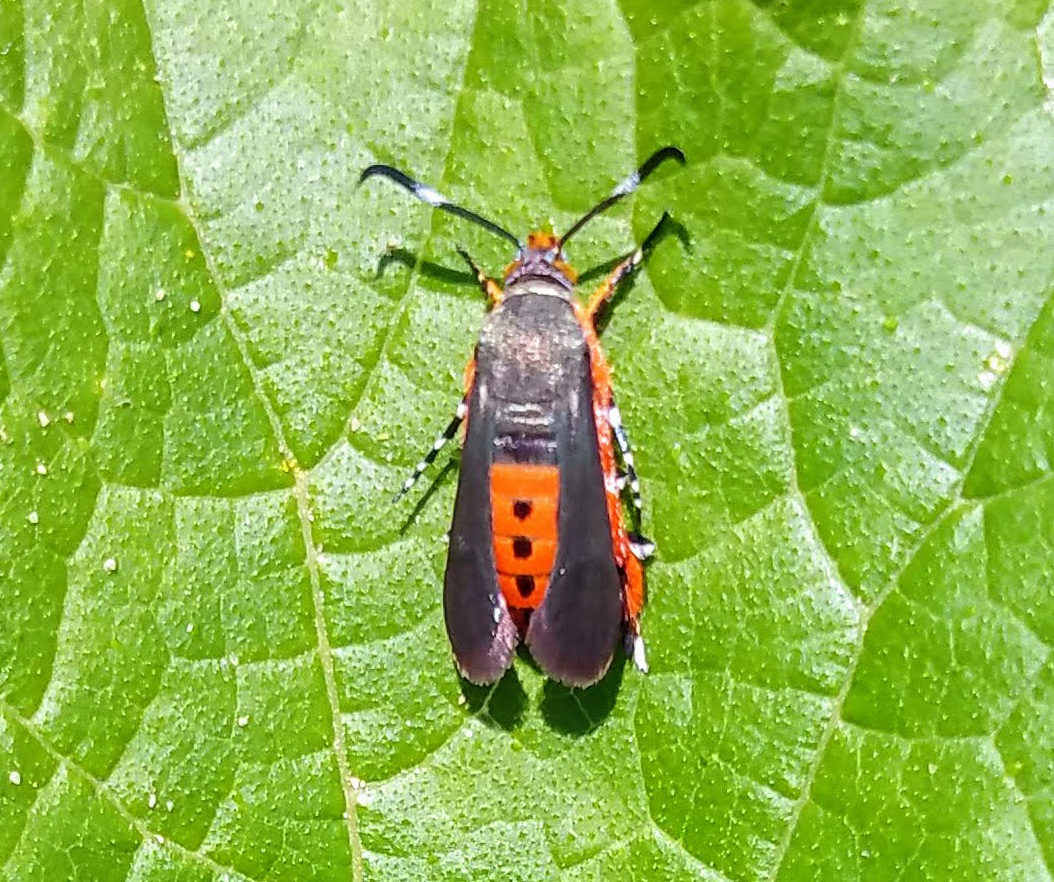West central Michigan vegetable update – July 1, 2020
It is a good year for pests that like hot weather.

Weather
Michigan is under a large upper air ridge in the Jetstream. This ridge is sandwiched between a trough to the east and west. This means the ridge will not move very much, bringing an extended period of warmer than normal weather, probably the longest stretch in a few years. This weather pattern also limits convection, which reduces chances of rain.
As a result, we will only see an outside chance of isolated showers on Friday afternoon, July 3. Otherwise, we could go a whole week without rain. Highs are forecast in the mid-80s to 90s through next Tuesday.
This will lead to high water demand for crops, with weekly potential evapotranspiration (PET) totals forecast for 1.3-1.7 inches. This translates to a daily PET rate of up to 0.25 inches. This is about as high as it gets in Michigan. It is not unusual to see PET rates this high in summer. What will be unusual is the longer streak of days that will see this high water demand over the next week. Note, PET is just a relative measure of water demand, actual demands vary by crop and growth stage.
The medium range forecast suggests a very strong chance of higher than normal temperatures for July 8-14. The precipitation forecast is less certain.
Over the next week, conditions may be ideal for the formation of inversions in the late evening through early morning hours. For spraying, a little light wind is better than no wind in these circumstances, as it indicates mixing is going on. Be especially cautious using volatile herbicides like dicamba and 2,4-D. Even if applied during a light wind, they can stick around and volatilize later on when inversions happen.
Crop updates
Asparagus shutdown is complete and fields are growing and branching. If you noted asparagus rust on stubble earlier this year (I saw this at one location), consider including tebuconazole along with a protectant in your first fern cover. Japanese beetles were flying in other crops I visited this week, and tarnished plant bugs have also been present in other crops. The standard grower insecticide mix, which includes permethrin and carbaryl, should cover these pests in addition to asparagus beetle.
Carrot growers may be considering their first topdress in the upcoming weeks. Given the very hot, dry conditions, it will be important to water urea in with irrigation. Given most carrots are already being irrigated, this shouldn’t be a problem. If it is not possible to irrigate within the week following application, consider using urea with a urease inhibitor.
Michigan State University Extension entomologist Zsofia Szendrei mentioned that aster leafhopper numbers typically peak in mid-June, but infectivity lags behind and peaks right about now. Approximately 4% of leafhoppers tested positive for aster yellows for an Oceana County sample pulled Monday. For all these reasons, now is a good time to treat for aster leafhoppers if you haven’t already. Asana is an effective choice.
Are you scouting for leafhoppers? Potato leafhopper is the main lookalike you might find, and it was quite abundant in one carrot field I visited this week. You can tell them apart pretty easily, as potato leafhoppers are neon green on top and bottom. Aster leafhoppers are olive green on top with dark black/brown undersides (Photo 1). A few other tips a good scout gave me: sweep so that the wind is blowing into your net if it’s windy, and when you have your catch ball up the bottom of the net in your hand to squish the leafhoppers. This makes them much easier to count, as squished or stunned ones won’t fly away and they are still easy to identify.
Celery scouts have detected aphid colonies in celery at three west Michigan farms at an earlier than normal time of year. If you don’t have a scout, field edges are a good place to check for initial aphid damage. Look for plants that are twisted up top with aphid colonies underneath. Movento (three-day preharvest interval) can be applied with a penetrating surfactant to provide excellent control. Two applications are allowed per season. Actara is also labeled, has a seven-day preharvest interval, and allows for three applications at the high labeled rate.
Scouts have seen some celery leaftier flying at low levels, but to date have not detected caterpillars in plants. Variegated cutworm remains a pest to look out for, especially if worm control products were not used early in the season.

Cole crops are continuing to develop. Cabbage white butterflies were very apparent yesterday in one field I scouted, but I did not detect any eggs or caterpillars. I have noticed this in prior years as well, and it suggests that scouting for caterpillars is probably the best way to decide if treatment is needed. In other words, seeing cabbage white butterflies is a good sign to be on the lookout for caterpillars, but they do not necessarily indicate treatment is needed.
Cucurbit downy mildew was detected in cucumbers on two Monroe County farms this week. Our hot, dry weather could help reduce the risk of disease spread. The downy mildew to date has all belonged to clade two, which is only of concern for melon and cucumber growers. It is not known to infect squash and pumpkin. Clade one can infect squash, but has not been detected to date in Michigan in 2020, and there are years when it is not detected at all.
Protecting new pickle plantings can be perplexing as growers weigh their spray bill against crop protection. It is important to note that even very young plants are susceptible to downy mildew. Cotyledons of cucumbers and melons can become infected, so protection of young plants is important. Banded applications can help lighten the burden of spraying small pickles, which are still being planted and can be quite small.
As you prepare for the powdery mildew season, I’d strongly encourage you to listen to last week’s Great Lakes Vegetable Producers Network podcast with mildew guru Meg McGrath. Her lab does annual trials and screens for fungicide resistance in powdery mildew in New York State. Visit her website to learn more, it includes a list of key modes of action that she recommends. For 2020, these include Vivando (FRAC 50), the DMI fungicides including Proline and Procure (FRAC 3), and Gatten (FRAC U13). Note, there is variability in the number of applications allowed, and the efficacy, of DMI fungicides. Proline or Procure could be options to consider.
Also, note that our powdery mildew could have a different resistance history than New York populations, so some products may work OK here that do not in the Northeast. For organic growers, using micronized sulfur products (e.g., Micro Thiol Disperss) has been effective, but it is important to not apply these close to application of oils. Oils can facilitate entry of sulfur into the plant, leading to injury. Micronized formulations of sulfur are less corrosive to equipment than other formulations.
Striped cucumber beetle remains a persistent pest for some growers this year. Prior to bloom, consider a long residual, broad-spectrum product like Sevin XLR Plus. Pre-bloom applications can be helpful in knocking back populations, as later on bees are always of concern. During bloom, application of a shorter residual pyrethroid (avoid microencapsulated products) or acetamiprid (e.g., Assail) in the evening may be less risky for pollinators.
Scouts detected squash vine borer adults in west central Michigan last week. This pest is typically most problematic in small plantings but can occasionally cause issues in larger plantings as well. Female moths are brightly colored and fly during the day and are not hard to spot in cucurbit plantings (Photo 3). Eggs are laid on the stem or crown, and hatching larvae bore into the stem, leaving behind a frassy entrance hole and causing vines to wilt. I have seen them present without any issues in the field, but if you have had a problem before you may again. Insecticide needs to be on the plant before eggs laid by these moths hatch, so caterpillars contact them and die before entering the vine. Once they are in the plant it is hard to control them. Learn more about squash vine borer. An initial application can be followed up by repeat, weekly applications for two to three weeks.

Onion growers should make sure to include “A-team” Stemphylium products in their rotation. In rank order, these could include:
- A-team: Luna Tranquility or Miravis Prime
- Second best: Tilt (tank mix with mancozeb to cover other pathogens)
- Third tier: Bravo
Bravo could be sandwiched between an A-team product and Tilt plus mancozeb. Making a “fungicide oreo” with Bravo in the middle can help ensure you don’t go more than 14 days without including a very effective material.
Onion thrips populations had increased significantly over the last week at locations I have scouted, but Movento was doing its job where it was applied. It was neat to see it work; in treated fields adult thrips were present, but larvae were scarce and Movento was keeping population increases at bay. Is it too late for Movento? Szendrei conducted trials with Movento for multiple years earlier in her career. She said that it is likely not too late, as she often made her first applications either the last week of June or the first week of July in her trials. This could be especially important for longer-maturity onions where you will need to cover more weeks with insecticide applications. If you apply Movento, use a non-ionic or penetrating surfactant and do not tank mix it with chlorothalonil.
Already past your two Movento applications? Read the Cornell University onion thrips management guidelines for 2020. If thrips populations are above 0.8 per leaf but below one per leaf, Agri-Mek can be an effective choice. Tank mixing it with Warrior may improve efficacy. If thrips populations are between one to two thrips per leaf, Minecto Pro is a good option for spray slot two. If they are over three per leaf, Radiant is the best choice. Hopefully Movento will allow you to skip at least one or two weeks of spraying, but make sure to scout as the hot, dry weather is ideal for rapid onion thrips population growth.
Potato and snap bean growers should be aware that potato leafhopper populations are exceptionally high this year in other crops.
Sweet corn growers may consider still being on the lookout for European corn borer in early corn. An affordable pyrethoid applied at tasseling and followed up with repeat applications at five-day intervals up to a week before harvest can provide control where this pest is of concern. Based on degree days at the Kent City and Hudsonville Enviroweather stations, the first flight should be coming to an end.
To date, I have not detected any corn earworm in an Oceana and Ottawa County trap. However, it has been detected in southeast Michigan at low levels, and a scout has also caught low numbers in a trap in Barry County, so it’s possible it is present. A five-day spray interval is typically sufficient for European corn borer control and for low populations of corn earworm. Intervals can be tightened depending on your buyer’s tolerance and (at least for earworm) hot weather.



 Print
Print Email
Email

